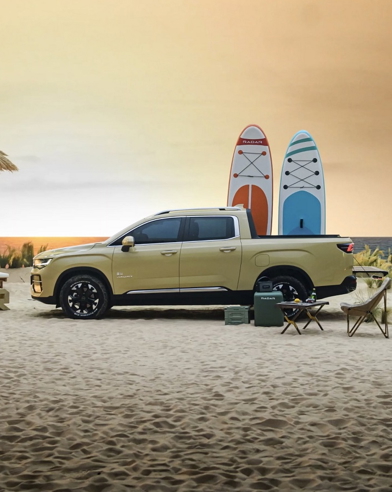As corporate slogans go, the maxim for China’s Great Wall Motors aims low. It promises that the company will improve “little by little”. That’s certainly true when it comes to exports outside China. Although the number of Great Wall utes and Haval-branded SUVs sent offshore increased by 125 per cent in 2017, the number still totalled a paltry 39,000 vehicles. Just 2200 reached Tasman Sea shores.
However, the launch of a new-generation ute at this month’s Shanghai auto show, can be considered what a former leader of the country would call “a great leap forward”.
The new ute, available in four variants, two wheelbases, and driving a state-of-the-art eight-speed automatic gearbox, sometimes with the help of three diff-locks while driving off-road, isn’t just a challenger to the present light truck sales hierarchy. It’s the second step in a three-stage business plan that will transform GWM from a strong regional player to a proper automotive manufacturer over the next five years.
GWM’s chief operating officer for Australia and New Zealand, Hidesuke Takesue, explains: “The first step is the development of the Haval SUVs, the second is the introduction of the new pick-up truck, and the third is the development of new technologies.” (The company’s Ora-branded EVs are already popular in China, and GWM is also developing hydrogen-fuelled electric vehicles).
“Times are changing, product for global markets still isn’t the focus, but the company is now seeking to develop overseas markets more.”
Back to that first step: near the Baoding headquarters of GWM we sampled new SUVs that could find their way into the New Zealand range if selected for our market.
The new-generation five-seat Haval H6 is a no-brainer, a handsome Mazda CX-5/Volkswagen Tiguan competitor with a fashionable turbocharged 1.5-litre direct-injection engine, a seven-speed dual-clutch transmission, and the potential to be competitively-priced. Built on a new platform, it displayed more refined steering and handling than the H6 model presently available in New Zealand. It’s like the H6 on sale here meets 20th-century standards of excellence, whereas the new one catches up with the rest of the compact SUV market and, in some instances, surpasses it.
The new Haval F7 and F7X models are distinguished by their rooflines, suspension set-up, and powertrains. Both are easy on the eye thanks to their design being lead by the talented Pierre Leclercq, and the F7 is more traditional looking while the X-machine opts for a sporty coupe-like roofline.
After a four-year stint at GWM, Leclercq has moved back to France to work as head of design for Citroen, but the former BMW M-division design leader leaves a strong legacy at Haval in the form of a trio of appealing SUVs (including the new H6). The F7 and F7X are already attracting a younger demographic of customers to Haval dealerships in China, where they’ve been on sale for more than a year.
The new powertrain of the H6 will address the major short-coming of the present model — fuel consumption. With its 1.5l turbo developing 128kW and 285Nm, and those outputs processed by a more efficient seven-speed dual-clutch gearbox than the present automatic, fuel use is likely to drop by more than 10 per cent.
Little wonder then that Haval’s new 1.5T has been voted China’s best new engine of 2018.
The F-series SUVs get more power in keeping with their sportier looks, with a new 2l turbo-petrol. It outputs 145kW and 345Nm in F7 form, rising to 165kW and 385Nm for F7X. Both models share the same 7-speed DCT as the new-gen H6, and the F7X offered the best chance of setting a fast time through Haval’s coned-out handing track.
The other contender for a “stage win” was the Wey VV-7, which strangely placed more power (172kW) but less torque (360Nm) than the F7X at the disposal of its driver. Wey is Haval’s new luxury brand and the name paraphrases that of the 55-year-old owner of 52 per cent of Great Wall Motors, Wei Jianjun. He’s China’s seventh-richest man, an admirer of Mao Zedong, and GWM workers march uniformly in formation to and from their work in his eight car plants. Evidently, the military precision also extends to the quality of Haval/Great Wall products.
“Chairman Wei is a manufacturing guy, a hardware guy — he knows how to put the metal together better than the average Chinese brand,” says Bill Russo, a former Chrysler executive now working as an automotive analyst in Shanghai.
But is Chairman Wei also a marketer?
We’ll wait a further 18 months for the new Great Wall ute, two years for the vastly improved Haval H6, and the technically advanced F7/F7X, Wey VV-7 and VV-6, and the expanding range of Ora electric vehicles might not come here.
Having a steady demand in its home market for the 1.1 million vehicles GWM makes annually might strengthen the foundations of the company, but it can also inhibit its global ambitions.




